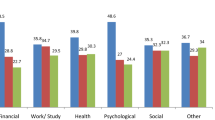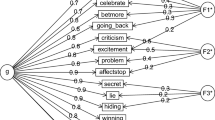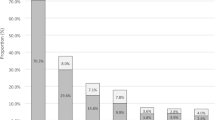Abstract
This article examines gambling harms from both gamblers and affected others’ perspectives. Participants (3076 gamblers and 2129 affected others) completed a retrospective survey that elicited information on harms they experienced from gambling across their lifetime. Their responses were analyzed through testing measurement invariance, estimating item-response theoretic parameters, calculating percentages, confidence intervals, and correlations, as well as regressions. The results indicated large commonalities in the experience of harms reported by gamblers and affected others. Further, gamblers appeared to ‘export’ about half of the harms they experienced to those around them. The findings also provided detailed profiles of evolving harms as problem gambling severity varies.


Similar content being viewed by others
Notes
Affected others is the general term we employ to describe any person with a significant relationship to a gambler who is affected by the gambler’s behavior.
References
Blaszczynski, A. (2009). Problem gambling: We should measure harm rather than ‘cases’. Addiction, 104(7), 1072–1074.
Browne, M., Langham, E., Rockloff, M. J., Li, E., Donaldson, P., & Goodwin, B. (2015). EGM jackpots and player behaviour: An in-venue shadowing study. Journal of Gambling Studies, 31(4), 1695–1714.
Chamberlain, S. R., Leppink, E., Redden, S. A., Odlaug, B. L., & Grant, J. E. (2016). Racial-ethnic related clinical and neurocognitive differences in adults with gambling disorder. Psychiatry Research, 242, 82–87.
Currie, S. R., Miller, N., Hodgins, D. C., & Wang, J. (2009). Defining a threshold of harm from gambling for population health surveillance research. International Gambling Studies, 9(1), 19–38.
Darbyshire, P., Oster, C., & Carrig, H. (2001). The experience of pervasive loss: Children and young people living in a family where parental gambling is a problem. Journal of Gambling Studies, 17(1), 23–45.
Dhillon, J., Horch, J. D., & Hodgins, D. C. (2011). Cultural influences on stigmatization of problem gambling: East Asian and Caucasian Canadians. Journal of Gambling Studies, 27(4), 633–647.
Dickson-Swift, V. A., James, E. L., & Kippen, S. (2005). The experience of living with a problem gambler: Spouses and partners speak out. Journal of Gambling Issues,. doi:10.4309/jgi.2005.13.6.
Dixon, M. J., Harrigan, K. A., Santesso, D. L., Graydon, C., Fugelsang, J. A., & Collins, K. (2014). The impact of sound in modern multiline video slot machine play. Journal of Gambling Studies, 30(4), 913–929.
Dowling, N. A., Suomi, A., Jackson, A. C., & Lavis, T. (2015). Problem gambling family impacts: Development of the Problem Gambling Family Impact Scale. Journal of Gambling Studies,. doi:10.1007/s10899-015-9582-6.
Evans, L., & Delfabbro, P. H. (2005). Motivators for change and barriers to help-seeking in Australian problem gamblers. Journal of Gambling Studies, 21(2), 133–155.
Ferland, F., Fournier, P. M., Ladouceur, R., Brochu, P., Bouchard, M., & Pâquet, L. (2008). Consequences of pathological gambling on the gambler and his spouse. Journal of Gambling Issues, 22, 219–229.
Ferris, J., & Wynne, H. (2001). The Canadian Problem Gambling Index: Final report. Submitted for the Canadian Centre on Substance Abuse.
Gainsbury, S., Hing, N., & Suhonen, N. (2014). Professional help-seeking for gambling problems: Awareness, barriers and motivators for treatment. Journal of Gambling Studies, 30(2), 503–519.
Hodgins, D. C., Stea, J. N., & Grant, J. E. (2011). Gambling disorders. The Lancet, 378(9806), 1874–1884.
Holdsworth, L., Nuske, E., Tiyce, M., & Hing, N. (2013). Impacts of gambling problems on partners: Partners’ interpretations. Asian Journal of Gambling Issues and Public Health, 3(1), 1–14.
Jacobs, D. F., Marston, A. R., Singer, R. D., Widaman, K., Little, T., & Veizades, J. (1989). Children of problem gamblers. Journal of Gambling Behavior, 5(4), 261–268.
Jauregui, P., Urbiola, I., & Estevez, A. (2016). Metacognition in pathological gambling and its relationship with anxious and depressive symptomatology. Journal of Gambling Studies, 32(2), 675–688.
Kalischuk, R. G., Nowatzki, N., Cardwell, K., Klein, K., & Solowoniuk, J. (2006). Problem gambling and its impact on families: A literature review. International Gambling Studies, 6(1), 31–60.
Krishnan, M., & Orford, J. (2002). Gambling and the family: From the stress-coping-support perspective. International Gambling Studies, 2(1), 61–83.
Langham, E., Thorne, H., Browne, M., Donaldson, P., Rose, J., & Rockloff, M. (2016). Understanding gambling related harm: A proposed definition, conceptual framework, and taxonomy of harms. BMC Public Health,. doi:10.1186/s12889-016-2747-0.
Li, E., Rockloff, M. J., Browne, M., & Donaldson, P. (2016). Jackpot structural features: Rollover effect and goal-gradient effect in EGM gambling. Journal of Gambling Studies, 32(2), 707–720.
Lorenz, V. C., & Shuttlesworth, D. E. (1983). The impact of pathological gambling on the spouse of the gambler. Journal of Community Psychology, 11(1), 67–76.
Lorenz, V. C., & Yaffee, R. A. (1988). Pathological gambling: Psychosomatic, emotional and marital difficulties as reported by the spouse. Journal of Gambling Behavior, 4(1), 13–26.
Medeiros, G. C., Leppink, E. W., Yaemi, A., Mariani, M., Tavares, H., & Grant, J. E. (2015). Electronic gaming machines and gambling disorder: A cross-cultural comparison between treatment-seeking subjects from Brazil and the United States. Psychiatry Research, 230, 430–435.
Orford, J., Templeton, L., Velleman, R., & Copello, A. (2005). Family members of relatives with alcohol, drug and gambling problems: A set of standardized questionnaires for assessing stress, coping and strain. Addiction, 100(11), 1611–1624.
Polokill. (2013). Favorite quotes from Breaking Bad. Retrieved from http://www.imdb.com/list/ls056274521/.
Rizopoulos, D. (2006). ltm: An R package for latent variable modeling and item response theory analyses. Journal of Statistical Software, 17(5), 1–25.
Rockloff, M. J., Browne, M., Li, E., & O’Shea, T. (2014). It’s a sure bet you’re going to die: Existential terror promotes gambling urges in problem players. Gambling Research, 26(1), 33–43.
Rodgers, B., Caldwell, T., & Butterworth, P. (2009). Measuring gambling participation. Addiction, 104(7), 1065–1069.
Rosseel, Y. (2012). lavaan: An R package for structural equation modeling. Journal of Statistical Software, 48(2), 1–36.
Salonen, A. H., Castrén, S., Alho, H., & Lahti, T. (2014). Concerned significant others of people with gambling problems in Finland: A cross-sectional population study. BMC Public Health,. doi:10.1186/1471-2458-14-398.
Svetieva, E., & Walker, M. (2008). Inconsistency between concept and measurement: The Canadian Problem Gambling Index (CPGI). Journal of Gambling Issues, 22, 157–173.
Vandenberg, R. J., & Lance, C. E. (2000). A review and synthesis of the measurement invariance literature: Suggestions, practices, and recommendations for organizational research. Organizational Research Methods, 3(1), 4–70.
Velleman, R., Cousins, J., & Orford, J. (2015). Effects of gambling on the family. In H. Bowden-Jones & S. George (Eds.), A clinician’s guide to working with problem gamblers (pp. 90–103). London, New York: Routledge/Taylor & Francis Group.
Wohl, M. J., Gainsbury, S., Stewart, M. J., & Sztainert, T. (2013). Facilitating responsible gambling: The relative effectiveness of education-based animation and monetary limit setting pop-up messages among electronic gaming machine players. Journal of Gambling Studies, 29(4), 703–717.
Acknowledgment
This research was funded by a grant from the Victorian Responsible Gambling Foundation. A previous version of this paper has been submitted as part of a research report to the Victorian Responsible Gambling Foundation.
Author information
Authors and Affiliations
Corresponding author
Ethics declarations
Conflict of interest
En Li has received research grants from the Victorian Responsible Gambling Foundation and Gambling Research Australia. Matthew Browne has received grants from the Victorian Responsible Gambling Foundation, the New Zealand Ministry of Health and Gambling Research Australia. Erika Langham has received grants from the Victorian Responsible Gambling Foundation, the New Zealand Ministry of Health and Gambling Research Australia. Matthew Rockloff has received grants from the Queensland Treasury, the Victorian Treasury, the Victorian Responsible Gambling Foundation, the New Zealand Ministry of Health and Gambling Research Australia. Vijay Rawat declares no conflicts of interest.
Ethical Approval
All procedures performed in this study were in accordance with the ethical standards of the institutional and/or national research committee and with the 1964 Helsinki declaration and its later amendments or comparable ethical standards.
Rights and permissions
About this article
Cite this article
Li, E., Browne, M., Rawat, V. et al. Breaking Bad: Comparing Gambling Harms Among Gamblers and Affected Others. J Gambl Stud 33, 223–248 (2017). https://doi.org/10.1007/s10899-016-9632-8
Published:
Issue Date:
DOI: https://doi.org/10.1007/s10899-016-9632-8




